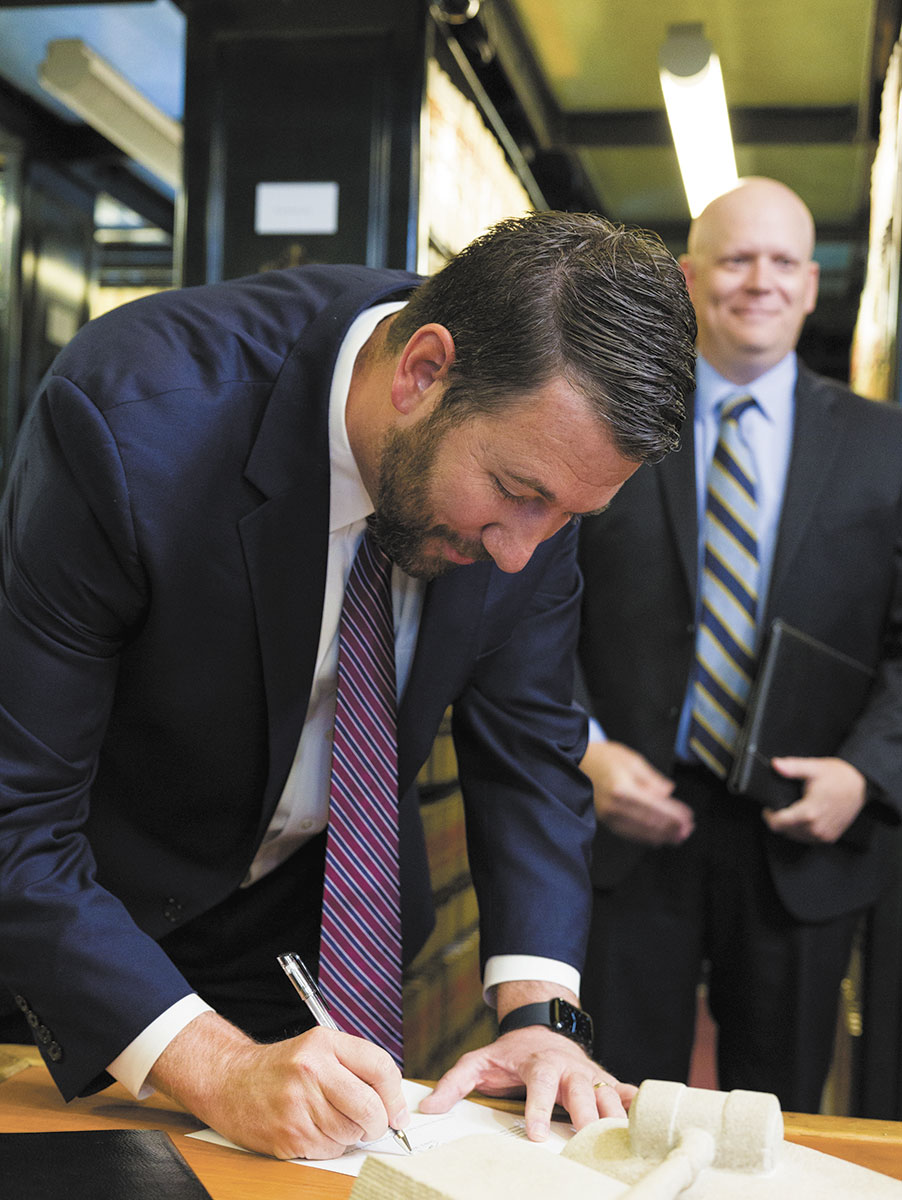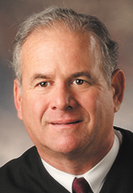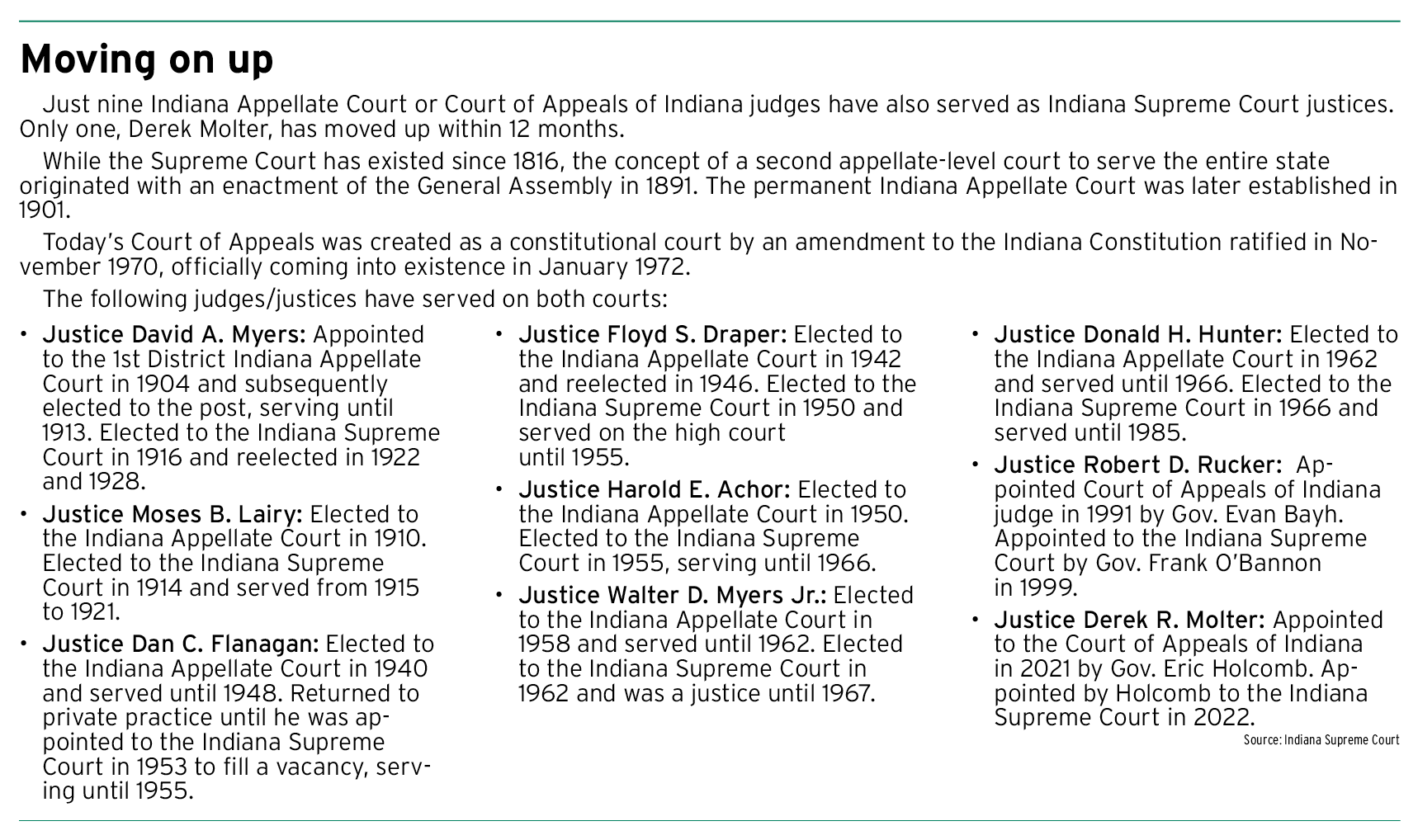Subscriber Benefit
As a subscriber you can listen to articles at work, in the car, or while you work out. Subscribe NowThe Indiana Supreme Court has a new justice on its five-member bench.
Last month, Justice Steven David officially retired from the state’s highest court and became a senior judge while now-Justice Derek Molter was sworn in as his successor.
Hundreds turned out for David’s retirement ceremony on Aug. 30, and two days later, a private swearing-in ceremony was held for Molter in the Supreme Court’s law library. Indiana Lawyer spoke with both the outgoing and incoming justices about their careers so far and what comes next.
_______________________________________________________________________________
Editor’s note: the graphic outlining the previous Indiana Supreme Court justices who also served on the Indiana Appellate Court bench is missing one judge/justice. Donald R. Mote was elected to the Indiana Appellate Court as judge in 1962 and served until being elected to the Supreme Court in 1966.
New Indiana Supreme Court Justice Derek Molter has recused himself from his first case on the docket for a unique reason: He outpaced it to the high court.
In 2021, then a partner at Ice Miller LLP, Molter argued before the Court of Appeals of Indiana for Vectren Energy Delivery in Indiana Office of Utility Consumer Counselor, et al. v. Southern Indiana Gas and Electric Company, et al., 21A-EX-821.
After being selected by Indiana Gov. Eric Holcomb to succeed retiring Court of Appeals Judge James Kirsch last fall, Molter withdrew himself from the case in preparation for joining the lower appellate bench on Oct. 1. It just so happened that Kirsch was one of the judges on the panel assigned to that same case.
Following a reversal by the Court of Appeals in January, the Supreme Court granted transfer to the case for the week ending June 3.
One week later, on June 10, Holcomb announced Molter as the state’s 111th justice, succeeding now-retired Justice Steven David.
Tomorrow, the Vectren case will go before the justices at 9 a.m. — Molter’s first day hearing oral arguments since taking the oath of office on Sept. 1.
Indiana’s newest justice will sit out of the energy company dispute but will get his first taste of being on the other side of the Supreme Court bench at 11 a.m. in Kyle Nicholas Doroszko v. State of Indiana, 21A-CR-1645.
Molter’s rapid ascent to the high bench is historic — no Court of Appeals judge has transitioned to justice faster. But those who know his work as an attorney and judge say they aren’t surprised.

Historically speaking
A review by Indiana Lawyer found just 10 justices in Indiana’s history have also served as Indiana Appellate Court or Court of Appeals of Indiana judges. None of the judges became justices within a year of their initial selection aside from Molter.
While the Indiana Supreme Court dates from the state’s first constitution adopted in 1816, the concept of a second appellate-level court to serve the entire state originated with an enactment of the General Assembly in 1891, according to the state’s archives.
In 1897, the second appellate court was retained for an additional four years and was recreated as the permanent Indiana Appellate Court in 1901.
The Appellate Court was abolished and today’s Court of Appeals was created as a constitutional court by an amendment to the Indiana Constitution ratified in November 1970, officially coming into existence in January 1972.
From 1816 to 1851, justices served seven-year terms and were appointed by the governor before being confirmed by the Indiana Senate. From 1851 to 1971, justices were elected by popular vote every six years.
For the past 51 years, the merit-based selection process has been used.
Since 1972, just one Court of Appeals judge — now-Senior Judge Robert Rucker — has been selected by a governor to serve as a justice besides Molter.
“Timing is sort of everything,” Molter said of his reasoning for applying for the open justice position. “It seemed like a job where I would have something to offer. Just like when I applied to the Court of Appeals, a lot of trusted colleagues consulted with me and urged me to apply.
“I gave it a lot of pause, largely because of how much I really enjoy this job,” Molter continued, referring to his work on the Court of Appeals. “But seeing that I think there’s something I can offer on the Supreme Court, I thought this is the time to go ahead and apply.”

In his lone year on the Court of Appeals, Molter wrote more than 100 opinions.
Although he saw Molter’s work in the Court of Appeals for a short time, Chief Judge Cale Bradford said the now-justice impressed him.
“I think he’s just a terrific and near-perfect blend of intellect, energy and humility,” Bradford said. “I think with his upbringing in a judicial family, he understands that judges have a lot of responsibility and that they have a lot of power — but they don’t need to use it most of the time. And so he treats everybody the same, which is impressive to me.”
Newton Superior Judge Dan Molter, who celebrated his 35th year in judicial office in 2021, echoed Bradford’s sentiments about his son’s character.
The father said seeing his son become justice is an “absolute whirlwind dream” for him and his wife, adding that his son has become a sort of cult-like figure in their rural community — but in a good way.
Making comparisons

As an undergraduate at Indiana University in 2002, Molter organized a student event centered around judicial selection and invited then-Chief Justice Randall Shepard to come on campus and speak.
In a still-online article by the Indiana Daily Student from nearly 20 years ago, Molter was quoted as saying, “Any time someone of such prominence comes to campus, it reminds us that IU is a place where leaders at all levels in all areas can engage in issues of the day,” following a speech by Shepard.
Fast forward to 2022 and Shepard, a senior judge on the Court of Appeals, occupied an office right next to Molter’s in the PNC Building in downtown Indianapolis.
The arrangement is fitting, given some in the profession have drawn comparisons between Molter and Shepard.
Shepard was just 38 years old when he joined the Supreme Court while Molter is currently 40 — the age Shepard was when he was named the youngest chief justice in the United States.
The senior judge called Molter’s path to the bench “highly unusual” given the historical context, but described him as an “especially gifted lawyer” with “superb talent” who is “inquisitive and inventive.”
Shepard said Molter’s time on the Court of Appeals and experience in appellate practice will aid him in his new job, and he guessed that the other justices are excited to get to work with him.
As the most-junior justice, Molter will be the first one to vote on cases.
Among the biggest adjustments Molter could face are the required leadership roles in the Supreme Court, as it often acts as a “board of directors” for the entire judiciary, Shepard said. Bradford said Molter was highly involved in court initiatives while on the COA, such as the Appeals on Wheels program, among others.
Molter outlined what he sees as the biggest challenges the courts face.
“An evergreen challenge is access to justice, and that’s made even more acute as more and more folks have difficulty trying to get counsel. That happens in a lot of areas of law,” he said. “There’s also a continuing concern about the public’s trust and faith in all of our government institutions, and the courts are not immune from that. We all have to keep working to earn and maintain that trust from the public, as well.”
Molter deflected numerous questions about himself, instead thanking his colleagues for helping him grow over the past year. He said he has leaned on numerous judges and senior judges on the Court of Appeals over the past year as he made the transition to judge.
The newest justice called David, who is now a senior judge, a “tremendous mentor” who brings out the best in everyone. He said he hopes to learn from David’s “integrity, accessibility and leadership.”•
Please enable JavaScript to view this content.


